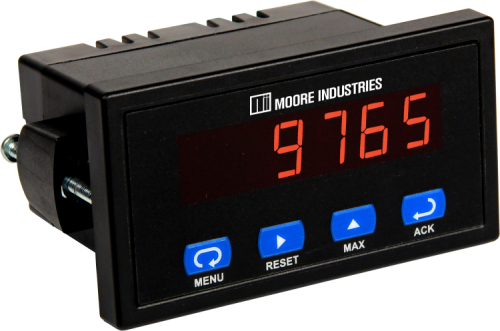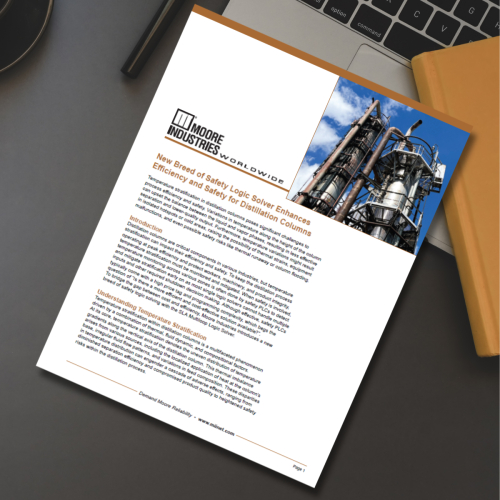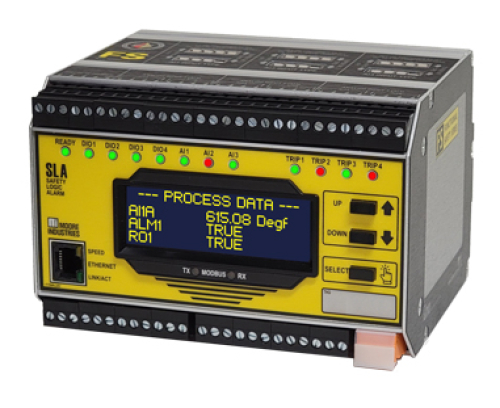Temperature sensor failure can wreak havoc on processes where maintaining temperature is critical and monitoring must be continuous. Whether it’s a runaway temperature that spoils a batch or a process interruption when an alarm shuts down the process due to a sensor failure, you lose time and money.
Dual input temperature transmitters with built-in backup and failover protection such as the THZ 3 and TDZ3 Dual Input Smart HART Temperature Transmitters from Moore Industries allow you to designate either of the sensors or inputs as the primary measurement and the secondary input acts as a backup sensor in case of a primary sensor failure.
One real world example involves the monitoring of critical temperatures in a chemical batch processing vessel (see Figure 1). It’s important to have the ability to maintain your temperature measurement in case of sensor failure. Single input temperature transmitters would require redundant sensors and transmitters that add to installation and maintenance costs. The THZ3 and TDZ3 with dual sensor input automatically switches to the backup sensor when the transmitter senses a primary sensor failure. This means that process monitoring can safely continue without interruption until the problematic sensor is replaced.
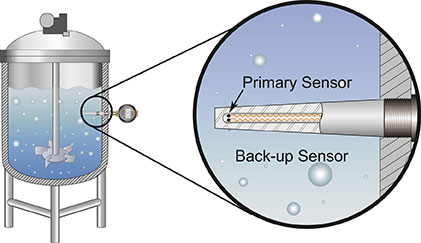
Figure 1. When reading critical temperatures in a chemical batch processing vessel, failover protection allows the secondary input of the Dual Input TDZ3 to act as a backup sensor when the primary sensor fails.
Multidrop Networks Save Time and Wiring Costs
The dual input capability also means that you can increase your temperature measurement points in a multi-dropped HART network. HART versions 5 and 6 allow up to 16 THZ3 or TDZ3 transmitters to be multi-dropped on one digital HART loop to monitor up to 32 temperature points. This reduces your DCS Input count, wiring costs, and transmitter count.
Any combination of THZ3 and TDZ3 transmitters can be connected in parallel onto a HART digital communication link (see Figure 2). This means you can use a single loop, instead of separate loops, to connect multiple transmitters. In a multidrop network, the transmitter’s measured process variable is output digitally, so the 4-20mA signal (locked at 4mA) is not used.

Figure 2. Multi-dropping several Smart HART transmitters onto a single digital data link saves time and money. Utilizing THZ3 or TDZ3 transmitters with dual inputs allows for cost-effective monitoring of several temperature points on one HART input channel.
A HART-based control system uses each transmitter’s individual address to configure, poll and view the transmitter’s data. A HART Communicator or other HART master with programming capability can be used in this configuration to access information from, or transmit configuration information to, the transmitter from anywhere on the HART loop.
Additional Dual Sensor Input Benefits
- Average and Differential measurements can be utilized to average the two input measurements or select either the differential (A-B or B-A) or absolute difference between the two inputs.
- High-Select and Low-Select features which enable the transmitter to continuously monitor two separate inputs and designate either the highest or lowest input as the source for the analog output or PV.
- Dynamic Variable Mapping that permits the user to assign either the input or the calculated result of the inputs to any of the four HART variables (PV, SV, TV and QV) that can be read by any HART-compatible host system.
Device Intelligence for Smarter Monitoring and Control
The THZ3 and TDZ3 come with Device Intelligence, a series of features for smarter control and monitoring including:
- Sensor drift and corrosion detection that checks and alerts users when the sensor is drifting out of a preset range or when the resistance due to corrosion exceeds set parameters.
- Smart range alarms with four HART alarms – set to any input or calculated input – that detect when the variable is within or outside of user preset limits.
- A High Availability option that enables the selection of how the AO behaves when there is an input failure or out-of-range value detected by the transmitter. This prevents nuisance alarms on startups or batch process shutdowns.
- Input simulation capability allowing manual input of a direct or calculated value. This essentially simulates a real input, allowing users to test the AO or any HART diagnostic and range alarms.
Dependability and Accuracy
Users can rely on the accuracy and dependability of the THZ3 and TDZ3. Their input-to-output analog accuracy of up to ±0.014°C (±0.025°F) utilizing sensor matching and trimming over a 100°F span is the absolute best in the industry. The transmitters feature 20-bit input resolution and deliver exceptional input accuracy for all sensor types.
Plus, Moore Industries’ patented continuous sensor diagnostics feature can save you from costly lost production and hours of troubleshooting. Advanced RFI/EMI protection and ambient temperature compensation guard against environmental factors that can quickly degrade measurement accuracy, while long-term stability provides up to five years between scheduled calibrations.
SIL 3 Capable STZ for Safety-Related Applications
End users who need a dependable and accurate temperature transmitter for use in Safety Instrumented Systems (SIS) where dangerous processes occur can turn to the SIL 3-capable STZ Functional Safety Dual Input Smart HART Temperature Transmitters. Part of the FS FUNCTIONAL SAFETY SERIES, the STZ has been certified by exida after rigorous evaluation to ensure conformance with strict IEC 61508:2010 standards for safety-related applications.
As with the THZ3 and TDZ3, the STZ has a dual sensor input that provides Backup and Failover Protection to reduce process interruptions. For example, the temperature is often a critical measurement in reactors, especially processes with the potential for thermal runaways due to exothermic reactions. Utilizing the failover/backup feature with dual sensor input on the STZ can help a Safety Instrumented System (SIS) mitigate potentially dangerous situations (See Figure 3).
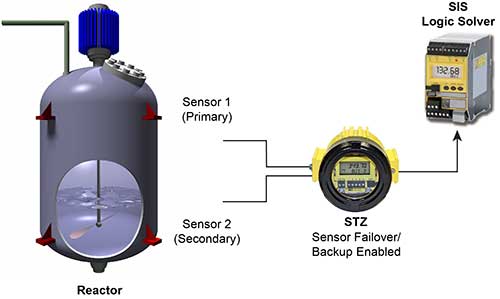
Figure 3. Temperature is often a critical measurement in reactors, especially processes with the potential for thermal runaways due to exothermic reactions. Utilizing the failover/backup feature with dual sensor input on the STZ can help Safety Instrumented Systems (SIS) mitigate potentially dangerous situations.
Discover Dual Input Temperature solutions from Moore Industries at www.miinet.com/HART-Temperature


